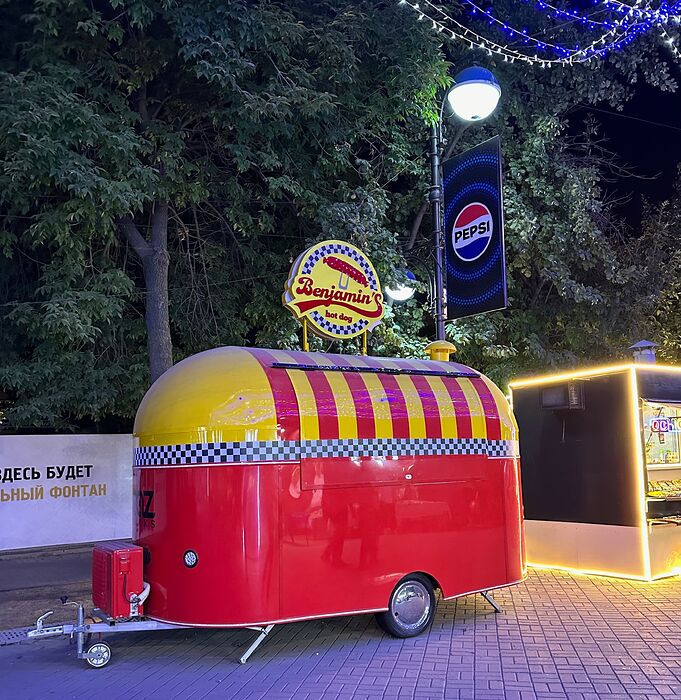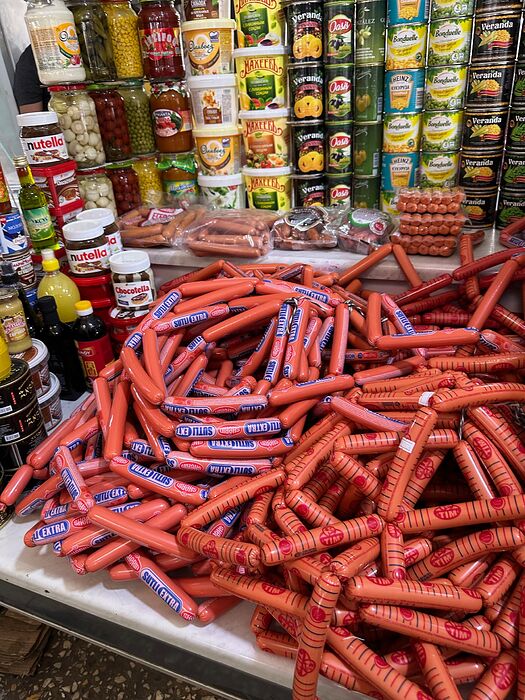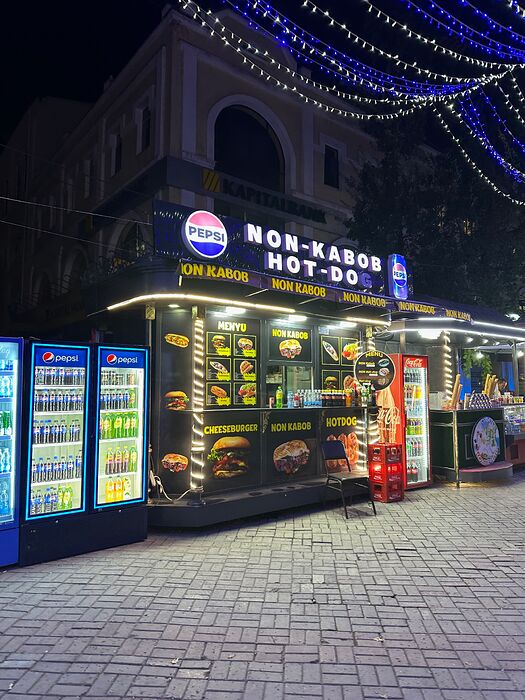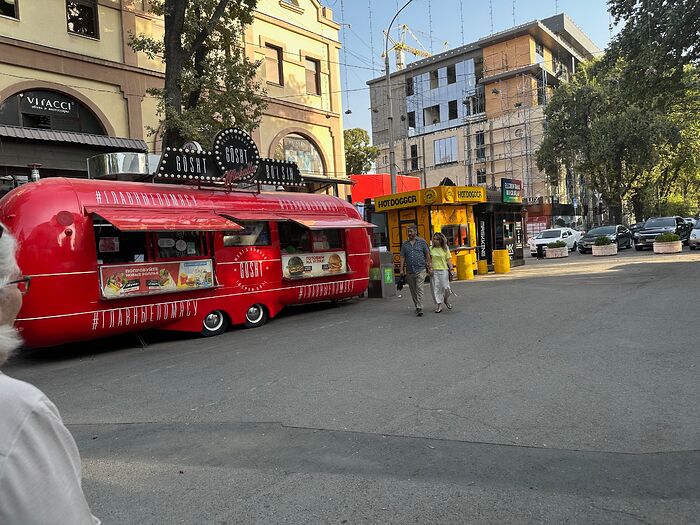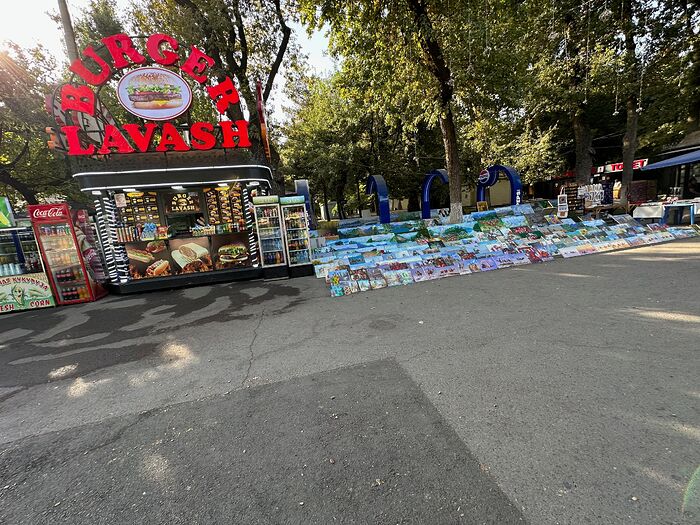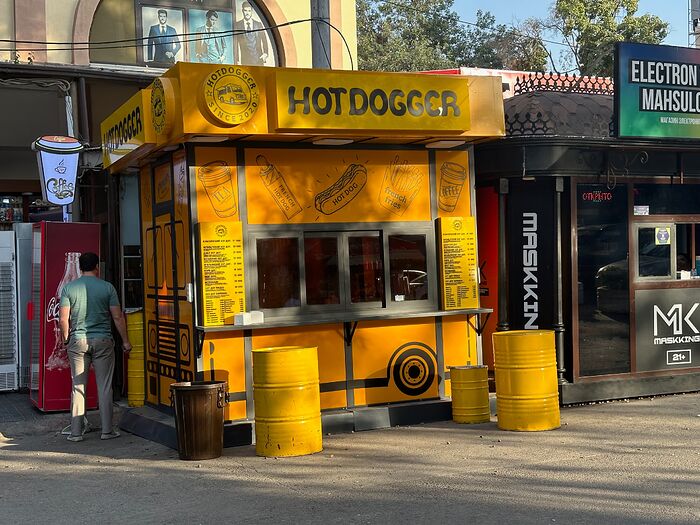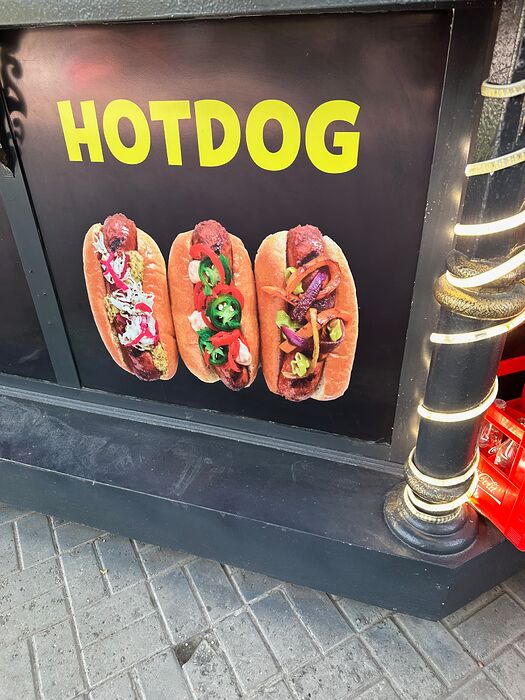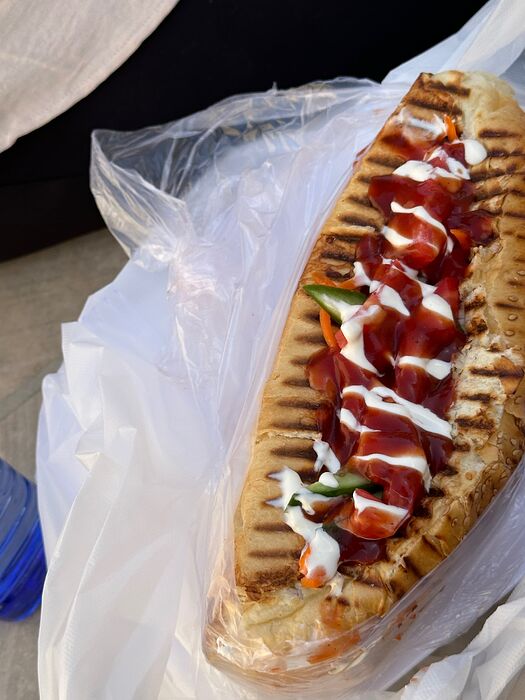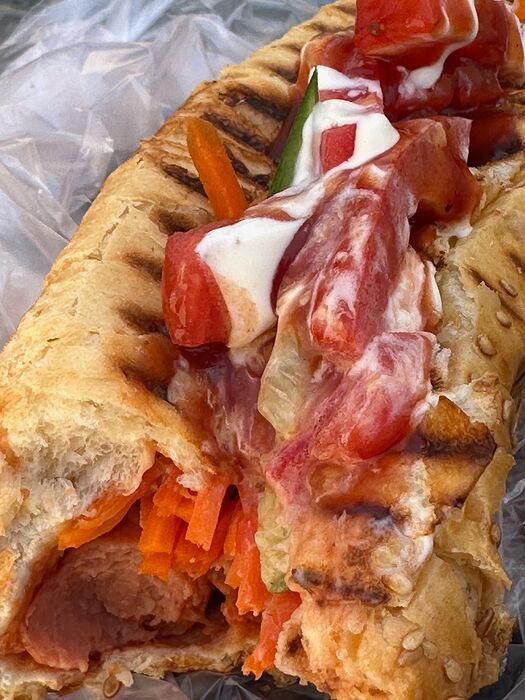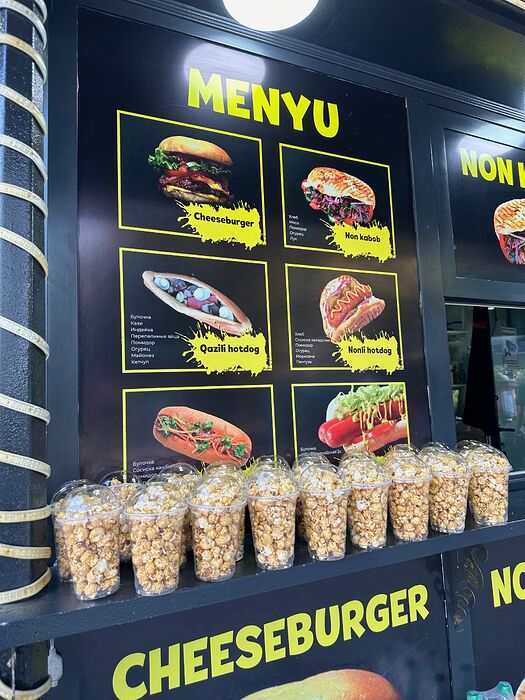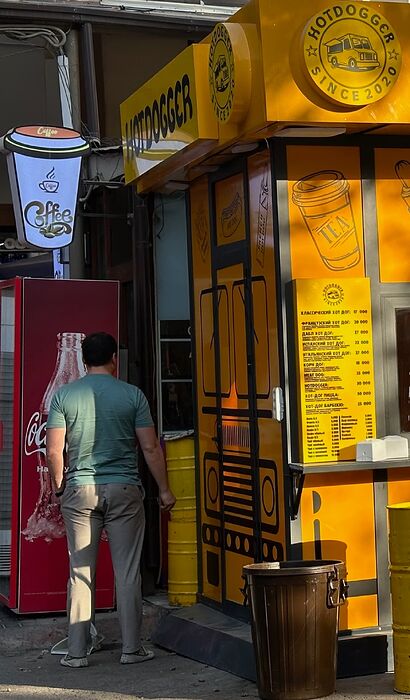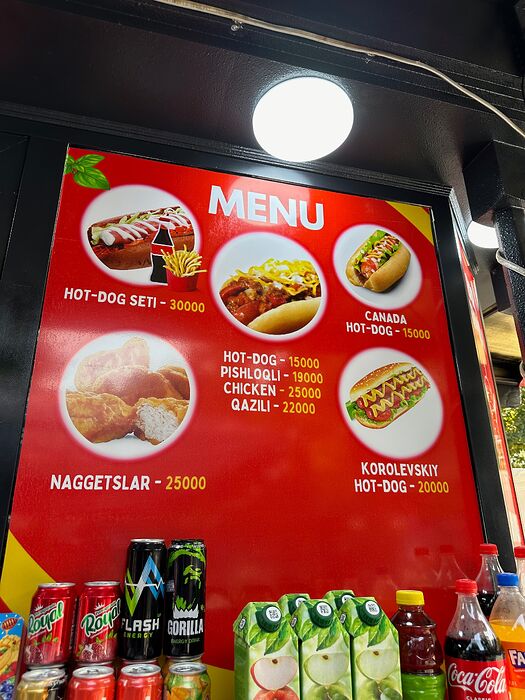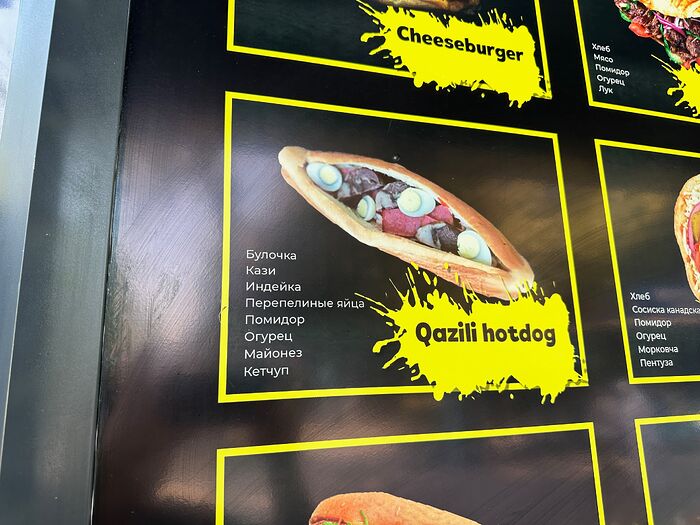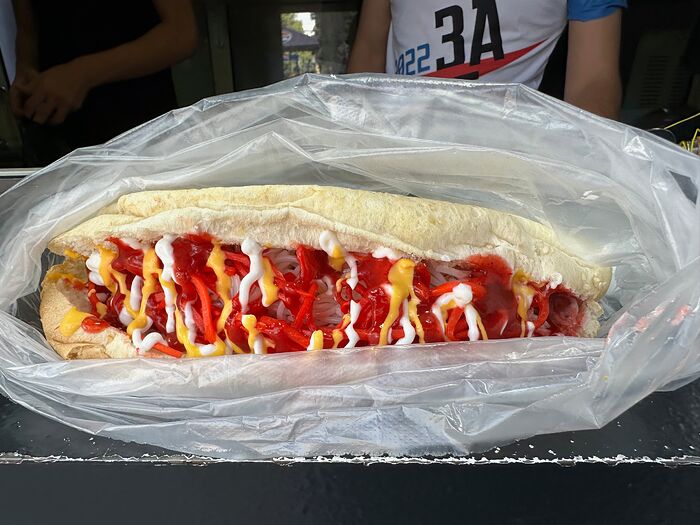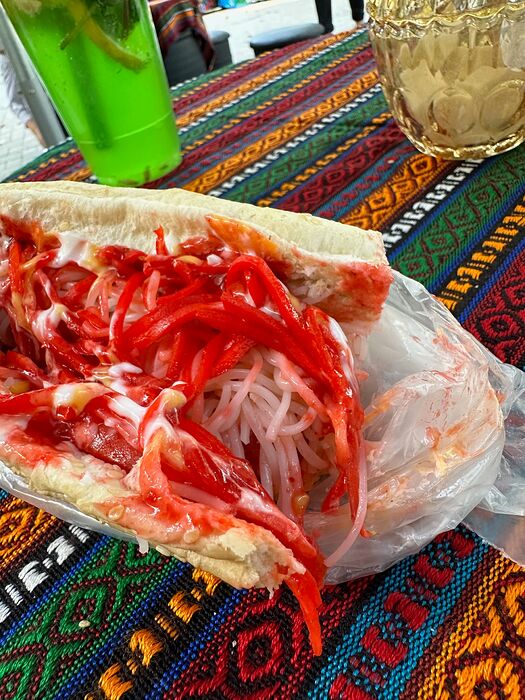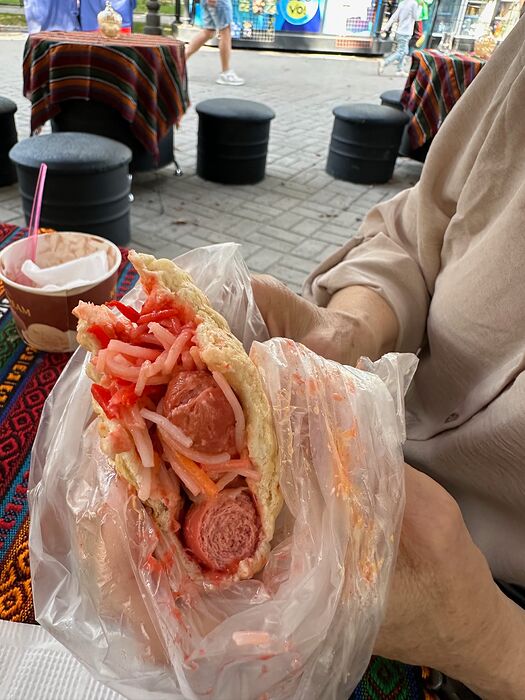Finally success - found it at the Green Bazaar in Almaty, Kazakhstan.
WELL worth the search.
At the risk of pomposity, I found it remarkably similar to the 1983 Riesling Kabinetts from the Mosel.
Low alcohol, a touch of sweetness, slight prickle on the tongue, and a lactic mouthfeel that I’ve only ever found in that 1983 vintage (Riesling was my first love).
Final meal in Almaty at Chef Restaurant (sign only in Cyrillic but downstairs at Negroni Bar). Easily the best meal of whole trip.
Wine selection not up-to-date - failed to produce either of our first two choices, but brought a selection from which we selected a 2017 Portuguese blend from Dao.
Some dishes were ‘off’ or ‘amended’ but we ended up with a pear and smoked horse meat salad - multiple greens, pine nuts and parmesan.
Mains were a slow cooked lamb ‘loin’ (actually top leg) with Asian Pumpkin and a Pita Burger - house-made sourdough Pita usingtheir own goat milk stuffed with grilled horse meat, assorted greens and onions.
Pavlova for dessert and now a nap before leaving for home.
wondering how were the flavors on these dishes, did they come off as western style food using local ingredients ( or as there some uniquenness in the seasoning?
its been great to have so much reporting in this little travelled region.
This is exactly what I’ve been thinking as I’ve read along!
The only person I knew until recently (ie till you talked about your trips) who had traveled in the region was a long-ago classmate who worked for the DoD (we would have suspected CIA but she talked too much and too openly about where she was going ![]() )
)
DOD and other federal agencies do language training in Tajikistan or at least were doing it when my daughter studied persian there
Not here trying to promote my lil’ ol’ blog, but if anyone is interested, they can browse through my entries from my second trip to Kazakhstan back in 2017, starting from the account on day 1:
It’s not ONLY about food, but I was a little more meticulous about documenting the food part compared to my entries from 2008. Still might be of interest to some people as this trip was planned around a Soyuz launch at Baikonur…
NOTE: LONG response (4 hour layover in Frankfurt Airport)
That question caused me to ponder what I was searching for and what biases I bring. So probably should be a separate ‘general’ thread.
However, let’s start here with a ‘wimpy’ answer “It depends”. There was a whole spectrum from specific local through ‘International’ style.
Specifically, some dishes rarely seen. I’d never before encountered Dill Noodles - let’s just say an acquired taste (I liked but Amuse Girl didn’t). But how different are they from, say, spinach noodles?
Kumis (fermented mare’s milk) is clearly a local dish (or drink). But again, how different from a yoghurt (in principle)?
Chef Restaurant in Almaty was (IMO) a brilliant fusion of Kazakh food with western technique. They claim that their dishes are adapted from a pre-Russian cookbook, but the techniques are imported from Western kitchens. The meats were mostly sous-vide and finished to order. The presentation was definitely ‘western’ with attention to colour and texture. The pear and smoked horse meat salad had multiple greens (they have their own greenhouse), some peppery, some bitter and various shades of green. Garnished with pine nuts (but we also saw local hazelnuts, walnuts etc - the climate supports those Ingredients). Their Pita bread was house made from a sourdough fed on goat’s milk (from a specific goat - the dough was started from the goat’s ‘Grandmother’).
They also featured a bone marrow dish - but I passed on that. Tried to order a starter of minced chicken with green apple (as a pate) served with banana bread - but not available that day - and bananas are imported, although green apples are everywhere. Found that place through some ’foodie research’ (maybe luck) but most of the places were dominated by Russian reviews - probably expected given the history and maybe 20% of the population being Russian speaking.
So lots of sour cream, red cabbage, beets, stews and potatoes (and vodka).
More generally, various incarnations of ‘Plov’ appeared everywhere. If there were differences in the rice ingredient, I failed to appreciate them. So, at first, it seems to be a traditional dish, but is it really any different from Paella, or Pilau (or a multitude of similar dishes). Sometimes topped with veggies (and/or meat) and sometimes cooked together with the veggies. If there were differences in spicing, I didn’t appreciate them - mostly bland (or subtle!), although, to be fair, the grains were mostly separate albeit occasionally over-oiled (to my taste). Corn and sunflowers were abundant, so were probably the oil base for all - but is it any different in western cuisine? I’ve had amazing Paella in Spain (occasionally) and disastrous Paella (usually) so that I rarely order it anywhere now - totally lacking the soccarat that makes the ‘authentic’ version stand out. But I’ve also had soccarat style rice in Turkey (Pilav) - cooked in what looks like a tandoori oven. Do I prefer the ‘western’ version, or the ‘local’ version? There’s a whole spectrum of ability and accomplishment in every cuisine.
For me, texture is very important (the theory is that, as one ages, one’s ability to ‘taste’ declines) and I found the noodle dishes much wetter than I’m used to in western cuisine - but that’s a personal preference - clearly, the styles are different.
Bizarrely, the most striking difference I observed was in the ‘Burgers’. I’m often perplexed by the number of pictures of Burgers I see on HO. I ‘get’ frozen vs ground vs chopped etc - but I (almost) never order them. On this trip I was struck (visually - didn’t order any) that the meat in the Burger seemed more like it was from a Doner Kebab - mixture of thinly sliced and small chunks of meat (but also rarer than one gets from Doner, or can get [legally] in western chains.). The fries were also different here - but most cultures care more than North Americans about the variety of potato they use.
Looking back, my highlights were:
Chef Restaurant (Almaty, Kazakhstan) - western techniques, local ingredients - but recipes adapted from a traditional cookbook
Traktir Konservator (Dushanbe, Tajikistan) a Ukrainian place serving ‘Russian’ style food - well prepared (and I’m not using Russian politically, but to emphasize ‘not Western’)
Cafe Uzum (Ashgabat, Turkmenistan) - ‘International cuisine’ - a well-spiced chicken stir fry (flat bottomed wok - tons of “wok hay”), with mainly onions and crunchy thin discs of potato.
City Restaurant & Cafe (Osh, Kyrgyzstan) Kebab of fat-bottomed lamb, perfectly cooked and seasoned (local, but Turkish heritage)
I just came across this and gee, its not fat BUTTS but FAT-TAILED sheep that is prized in this region. Yeah sometimes the fat is stored in the hindquarters too like some of the sheep in your pic but also in the fat tails of this breed https://en.wikipedia.org/wiki/Fat-tailed_sheep
I understand that some of the Uzbek/Tajik restos in NY do obtain these - and the skewers are really delish when you can get them
I forgot to ask, is UZ still censoring social media? we werent able to get on many accounts when we were in UZbekistan.
I didn’t notice any social media censorship. I got on YouTube, TikTok, and Facebook with no problems that I recall.
good - they have loosened up since our visit.
Heading to Dushanbe in a couple of weeks on a nature trip -back through Samarkand and Beldersay up to Tashkent for the flight home. Its a group so little chance to have an impact on eating choices except for the first couple days in Dushanbe ahead of the trip. I have been able to have some influence on these trips in othe places - and Im sure I can help with food choices- but everyting tends to be prearranged once the group is assembled and underway. Looking forward to getting back to that part of the world!
Hope to see you this summer!
If you end up with a group for a meal in Tashkent, there are a couple of places that I’d recommend you consider that might be especially congenial for a large group.
Tandiriyi Restaurant is experimenting with serving traditional Uzbek food in upscale surroundings. It definitely caters to tourists – even to the extent of offering plastic gloves to tourists who are queasy about eating with their hands – but the food was excellent. The prices were high by Tashkent standards, but unless the exchange rate has changed, extremely reasonable by US standards.
The only restaurant we ate in twice in Tashkent was Syrovarnya, which is actually part of a small chain of restaurants that started in Moscow. Really nice environment and excellent Italian food (they make their own stracciatella onsite).
Both restaurants would be very comfortable places for a large-ish group to eat, I think.
HOT DOGS IN UZBEKISTAN
I meant to post about Uzbek hot dogs when we were in Uzbekistan 9 months ago, but it turned out that there was a lot of research needed and, even more time-consuming, a lot of attempts at translating Cyrillic characters, from the local Uzbek version of Russian. So, here goes, better late than never.
I was not expecting hot dogs to be a thing in Uzbekistan; I’m not naive, I know that hot dogs are very popular in many far-flung places (like Brazil, whose mega-loaded dogs are world famous). But it just never occurred to me that Uzbekistan might be crazy for hot dogs.
But they are everywhere. The markets have huge piles of hot dogs. And there are hot dog stands everywhere, with menus that often also feature burgers and kabobs on naan. I actually only ended up eating a hot dog twice, once from a takeout stand in Bukhara and once on Broadway, an outdoor carnival-like street entertainment area in Tashkent.
But I was never sure what I would get if I ordered a hot dog. At the takeout stand in Bukhara (where we had a conversation while standing in line with an 8th grade girl who spok – amazingly – five languages - English, German, Russian, Uzbek, and Tajik), there were several varieties of hot dogs shown on the menu. I excitedly googled the particular one I had ordered (shown below, sorry for the partially eaten shot) only to find that I had ordered a “hot dog with two weenies,” which wasn’t a lot of help in figuring out the ingredients.
Despite not knowing what was on it, the hot dog was delicious, one of the best hot dogs I’ve ever had. The highlight was this huge dollop of fermented carrots. From subsequent research, it turns out that these carrots are the distinctive ingredient of Uzbek hot dogs.
The carrots are known as morchovka. Morchovka, which is julienned carrots mixed with ingredients like red pepper, coriander, garlic, vinegar, and oil, and then fermented. The historical antecedents of morchovka are ugly. In 1937, Stalin forcibly relocated about 200,000 Soviet citizens of Korean origin to Uzbekistan (and, I think, to other locations in central Asia). These Korean emigres adapted kimchi to local ingredients and came up with morchovka, which became a near-ubiquitous hot dog topping in Uzbekistan.
Along with liberal amounts of tomatoes, ketchup, and mayo, plus a large Uzbek roll (much larger than a US hot dog roll), the morchovka makes a fantastic hot dog, especially if you love wet, sloppy hot dogs.
Back in Tashkent, at the Broadway Avenue street fair, the hot dog menus were even more varied and more challenging.
I don’t think I’ve succeeded in understanding Uzbek hot dogs very well. From research it appears that the sausage (“qazi”) on most Uzbek hot dogs is made with horsemeat, although the sausages I had were much juicier and tastier than the dry-ish strips of horsemeat that top most heaping servings of plov, the national dish. Despite my googling and Chat-GPT’ing, I am not 100% convinced that the two juicy hot dogs I had in Uzbekistan were made with horsemeat.
The non-horsemeat hot dog sausages appear (and I stress “appear,” because I am far from understanding this area of Uzbek cuisine) to be called Canadian hot dogs, which appear on a lot of menus. Some sources suggest that this sausage is actually imported from Canada, though that seems improbably expensive to me.
The most intriguing variation, which we saw on multiple menus, was the Qazili hot dog, which is a hot dog with quail eggs. Sadly, I did not order this.
At one hot dog stand, they actually listed some of the ingredients, but it was tough going translating this. Other than quail eggs, many of the ingredients looked pretty straightforward – cucumber, tomato, ketchup, etc., but the Canadian dog listed “turkey” as an ingredient and I have been completely unable to translate the word Пентуэа.
So I did what I often did on our trip to Uzbekistan, just looked at the menu photos and pointed to the one that looked interesting. At this Broadway hot dog stand, this led me to order the “nonli hot dog,” if my memory is correct.
This was a fascinating hot dog, even sloppier and tangier than the one in Bukhara. But what stumped me was that it had cold rice noodles on it, which I had no clue about. It was extremely good, but there might be a little bit of a learning curve with the cold noodles part.
Anyway, no one at either of the hot places I went to in Uzbekistan spoke English, so I was unable to ask any clarifying questions. However, I see that an Uzbek hot dog place has opened in the Midwood neighborhood of Brooklyn (LavashUzN1). We’re on vacation in Brooklyn this month, so maybe we’ll check this out (and hope for English good enough that I can get a more accurate education about Uzbek hot dogs).





